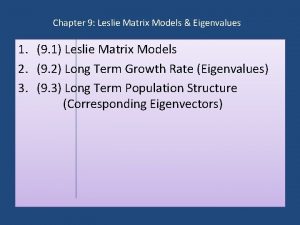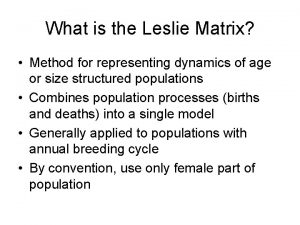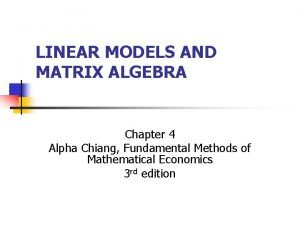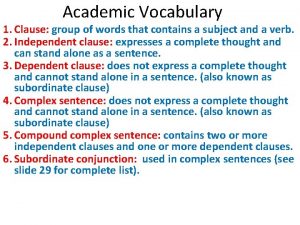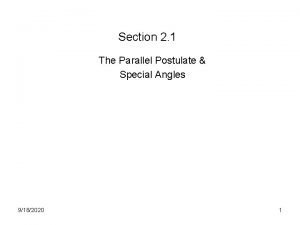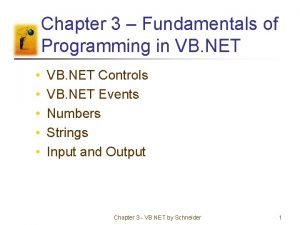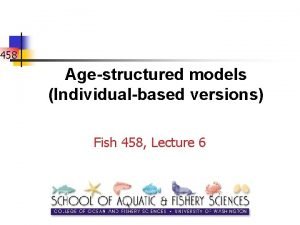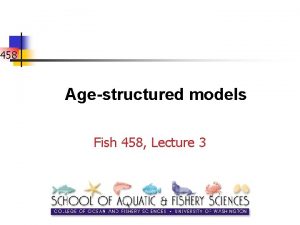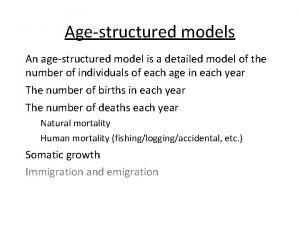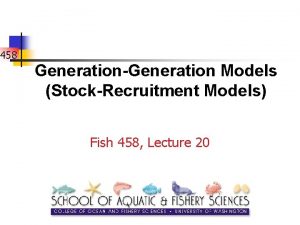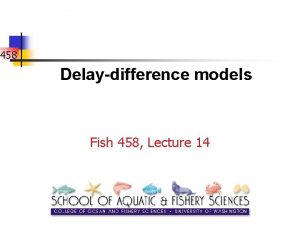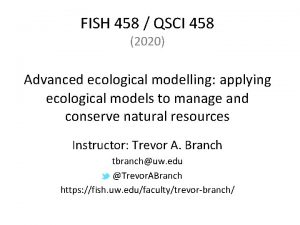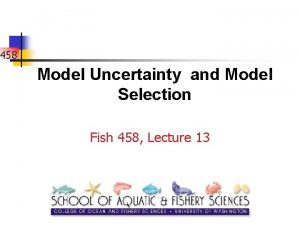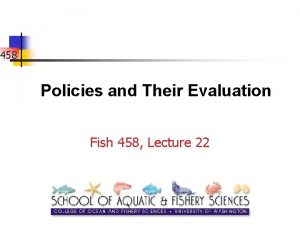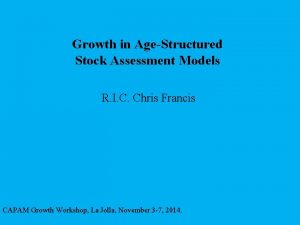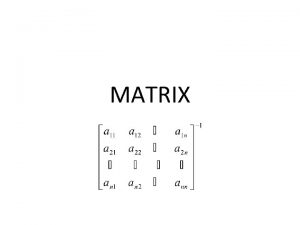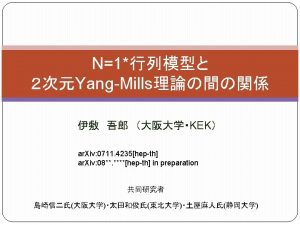458 Agestructured models continued Estimating from Leslie matrix



















- Slides: 19

458 Age-structured models (continued): Estimating from Leslie matrix models Fish 458, Lecture 4

The facts on 458 • Finite rate of population increase • =er & r=ln( ), therefore Nt=N t • A dimensionless number (no units) • Associated with a particular time step (Ex: =1. 2/yr not the same as = 0. 1/mo) • >1: pop. ; <1 pop

458 Matrix Population Models: Definitions • Matrix- any rectangular array of symbols. When used to describe population change, they are called population projection matrices. • Scalar- a number; a 1 X 1 matrix • State variables- age or stage classes that define a matrix. • State vector- non-matrix representation of individuals in age/stage classes. • Projection interval- unit of time define by age/stage class width.

458 Basic Matrix Multiplication 4 x 1 + 3 x 2 + 2 x 3 = 0 2 x 1 - 2 x 2 + 5 x 3 = 6 x 1 - x 2 - 3 x 3 3 2 x 1 2 – 2 5 x 2 1 – 1 3 x 3 4 = 1 0 = 6 1

458 What does this remind you of? n(t + 1) = An(t) Where: A is the transition/projection matrix n(t) is the state vector n(t + 1) is the population at time t + 1 This is the basic equation of a matrix population model.

Eigenvectors & Eigenvalues 458 When matrix multiplication equals scalar multiplication v. A = v v, w = Eigenvector Aw = w = Eigenvalue • Rate of Population Growth ( ): Dominant Eigenvalue • Stable age distribution (w): Right Eigenvector • Reproductive values (v): Left Eigenvector Note: “Eigen” is German for “self”.

458 Example: Eigenvalue A x = y 3 -6 4 2 -5 1 3 = No obvious relationship between x and y A x = y 3 -6 1 -3 4 2 -5 1 = -3 Obvious relationship between x and y: x is multiplied by -3 Thus, A acts like a scalar multiplier. How is this similar to ?

Characteristic equations 458 From eigenvalues, we understand that Ax = x We want to solve for , so Ax - x = 0 (singularity) or (A- I)x = 0 “I” represents an identity matrix that converts into a matrix on the same order as A. Finding the determinant of (A- I) will allow one to solve for . The equation used to solve for is called the Characteristic Equation

458 Solution of the Projection Equation n(t+1) = An(t) 4 - P 1 F 2 2 - P 1 P 2 F 3 - P 1 P 2 P 3 F 4 = 0 or alternatively (divide by 4) 1 = P 1 F 2 -2 + P 1 P 2 F 3 -3 + P 1 P 2 P 3 F 4 -4 This equation is just the matrix form of Euler’s equation: 1 = Σ lxmxe-rx

458 Constructing an age-structured (Leslie) matrix model n n n Build a life table Birth-flow vs. birth pulse Pre-breeding vs. post-breeding census n n n Survivorship Fertility Build a transition matrix

458 n n Birth-Flow vs. Birth-Pulse Birth-Flow (e. g humans) Pattern of reproduction assuming continuous births. There must be approximations to l(x) and m(x); modeled as continuous, but entries in the projection matrix are discrete coefficients. Birth-Pulse (many mammals, birds, fish) Maternity function and age distribution are discontinuous, matrix projection matrix very appropriate.

Pre-breeding vs. Post-breeding Censuses 458 Pre-breeding (P 1) Populations are accounted for just before they breed. Post-breeding (P 0) Populations are accounted for just after they breed

Calculating Survivorship and Fertility Rates for Pre- and Post-Breeding Censuses 458 Different approaches, yet both ways produce a of 1. 221.

The Transition/Population Projection Matrix 458 4 age class life cycle graph

458 Example: Shortfin Mako (Isurus oxyrinchus) Software of choice: Pop. Tools

Mako Shark Data 458 Mortality: M 1 -6 = 0. 17 M 7 -w = 0. 15 Fecundity: 12. 5 pups/female Photo: Ron White Age at female maturity: 7 years Reproductive cycle: every other 2 years

Essential Characters of Population Models 458 Ø Asymptotic analysis: A model that describes the long-term behavior of a population. Ø Ergodicity: A model whose asymptotic analyses are independent of initial conditions. Ø Transient analysis: The short-term behavior of a population; useful in perturbation analysis. Ø Perturbation (Sensitivity) analysis: The extent to which the population is sensitive to changes in the model. Caswell 2001, pg. 18

458 Uncertainty and hypothesis testing Characterizing uncertainty • Series approximation (“delta method”) • Bootstrapping and Jackknifing • Monte Carlo methods Hypothesis testing • Loglinear analysis of transition matrices • Randomization/permutation tests Caswell 2001, Ch. 12

458 References Caswell, H. 2001. Matrix Population Models: Construction, Analysis, and Interpretation. Sunderland, MA, Sinauer Associates. 722 pp. Ebert, T. A. 1999. Plant and Animal Populations: Methods in Demography. San Diego, CA, Academic Press. 312 pp. Leslie, P. H. 1945. On the use of matrices in certain population mathematics. Biometrika 33: 183 -212. Mollet, H. F. and G. M. Cailliet. 2002. Comparative population demography of elasmobranch using life history tables, Leslie matrixes and stage-based models. Marine and Freshwater Research 53: 503 -516. Pop. Tools: http: //www. cse. csiro. au/poptools/
 Eecs 458
Eecs 458 Komplemen 9 dari 458 =
Komplemen 9 dari 458 = Ece 457
Ece 457 Komplemen 2 biner
Komplemen 2 biner Ece 458
Ece 458 Leslie matrix example
Leslie matrix example Leslie matrix example
Leslie matrix example Leslie matrix
Leslie matrix Modals differences
Modals differences 2x1 matrix
2x1 matrix What is the definition of chemical potential energy
What is the definition of chemical potential energy Demonstrative adjectives continued answers
Demonstrative adjectives continued answers Continued slide
Continued slide Rene magritte meditation
Rene magritte meditation Older television sets had tubes
Older television sets had tubes Summary of romeo and juliet act 2, scene 6
Summary of romeo and juliet act 2, scene 6 Continued proofs transversals and special angles
Continued proofs transversals and special angles 9-7 solving quadratic equations by using square roots
9-7 solving quadratic equations by using square roots Table continued
Table continued To be continued
To be continued





